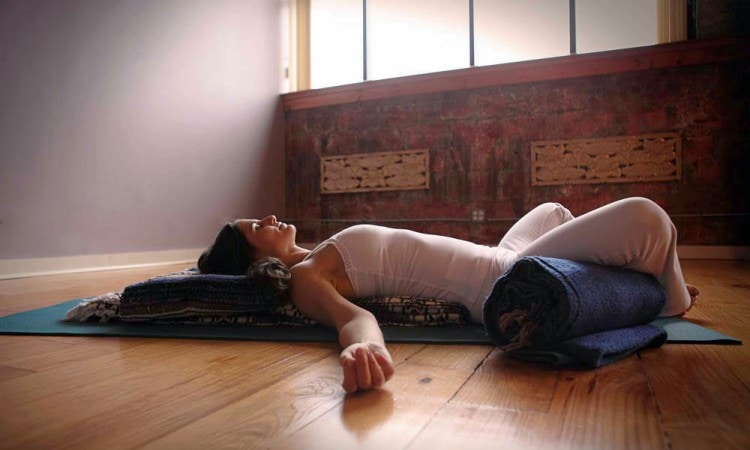Sometimes you’ve just got to slow everything right down.
When your life is racing full-speed ahead, so is your mind. Restorative yoga helps provide that physical and mental balance to prevent stress and anxiety, through the use of props that allow you to hold poses longer, giving you all the benefits of deep, passive stretching.
Poses like Child’s Pose, Legs-Up-the-Wall, and Savasana must be held for at least a few minutes, and you can stay in place for up to 15 minutes using bolsters, pillows, straps, blocks, etc. to support your body in a full, long, and comfortable stretch.
Though moving your body helps you find space, sometimes you might crave a sense of peace and calm. A great way to slow things down is with a regular meditation practice. Meditation soothes the mind and often focuses on the breath, which helps you find a sense of quiet as your busy day goes on. Sign up for the 30 Day Meditation Challenge to complement your restorative yoga flow. You’ll feel more open and the body will be better prepared to move with intention.
Here are the top reasons to spend a little extra time opening up and breathing in the benefits of this nourishing yoga practice.
1. Benefit from Full and Deep Stretches
Think you have to “work” to give your body benefit? Active practice is fabulous, but there’s only so long that you can stay in an intense backbend without feeling the burn. Long, supported poses help your body to fully engage, soften, and allow the precise positioning to work its magic.
2. Enhance Flexibility
All forms of yoga help make you bendier, but regular use of restorative poses leads you more quickly to this nirvana.
However, Restorative yoga is not a stretching class and there is no end goal involved, like being able to touch your toes after 10 sessions. You are exploring what happens when you release the tension your body habitually holds.
3. Find out Where You Hold Your Stress
Restorative poses give you the opportunity to notice where you hold this tension—kind of like a dye that sticks to the parts of you that are bound-up and dense. Once you come to this realization, you can make small changes in your everyday life to reduce the stress and tension you allow to build up in your body.
4. Trim Fat and Lose Weight
A 2013 study from the University of California, San Diego showed that restorative yoga helps overweight women trim fat. The study compared restorative yoga with a more active stretching regime over 48 weeks, and found that women practicing yoga lost more subcutaneous fat.
The yogis also lost more weight than the stretchers. One explanation may be that restorative yoga reduces cortisol levels—of which high levels are linked to increased abdominal fat.
5. Boost Your Immune System
A regular restorative yoga practice helps to improve your immune system and makes you less of a victim in the face of all those cold and flu viruses flying around.
6. Balance Your Nervous System
Use a restorative practice to engage your nervous system and take your body into a state that allows for renewal and rejuvenation. Benefits include optimizing energy flow to the organs, tissue renewal, and reduced “fight or flight” response.
7. Quiet Your Mind
Restorative yoga can be a calming hug for your overstimulated mind. Beware, though—it may look like the yogi is taking a nap, but once you get into them, you realize how challenging they can be. Be patient; just because your body is resting doesn’t mean your mind will automatically grow silent.
Over time, you will learn how to drop into a place of stillness and be content peacefully basking in the present moment.
8. Recover from Illness
We all need rest, whether or not you’re recovering from muscle strain, a broken bone, a bad bout of flu, or a chronic illness. Just because you’re not practicing more “active” asanas doesn’t mean you can’t benefit from yoga’s healing powers.
Restorative yoga allows you to practice when your energy is low and your body is building strength.
9. Heal Emotional Pain
Just as you need to build physical strength after illness, you need to heal emotional injuries. Restorative poses offer soothing care for when you are processing the loss of a loved one or a relationship, coming to terms with a change in your life, or dealing with depression or anxiety.
10. Segue to a Meditation Practice
If you want to benefit from meditation and you’re not sure how to start or how to continue, Restorative yoga provides a bridge between familiar poses and, to many, the unfamiliar and often intimidating practice of meditation.
You may feel vulnerable, emotional or anxious when practicing Restorative yoga—this is all part of the powerful process where you create space and let go. Wearing an eye mask, wrapping yourself in a blanket, or keeping your feet up on the wall can help ground and calm you.
Some poses help your heart, some assist your lungs. Others benefit the entire body. All are nourishing and life-enhancing when practiced regularly.
Image Credit: Monica Broz, Yogini: Jillian Pransky


